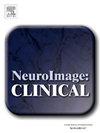颅脑损伤后的脑活动动态表明状态转换能量增加,对低阶状态的偏好增加
IF 3.6
2区 医学
Q2 NEUROIMAGING
引用次数: 0
摘要
创伤性脑损伤(TBI)可导致大脑神经组织和白质连接的结构性损伤,破坏其功能协同激活模式。尽管有大量的研究调查了脑外伤相关的大脑结构和功能连接体的变化,但很少有研究调查脑外伤相关的大脑动态景观的变化。网络控制理论是一个整合结构连接体和功能时间序列来量化大脑动力学的框架。使用这种方法,我们分析了两组轻度和中度至重度TBI个体从急性到慢性损伤阶段的脑动力学纵向轨迹,并将其与非脑损伤、年龄和性别匹配的对照组个体的轨迹进行了比较。我们的分析表明,轻度TBI患者最初的脑活动动态与对照组相似,但在损伤的亚急性和慢性阶段(损伤后1个月和12个月),与高阶默认模式优势状态相比,倾向于低阶视觉优势状态。我们进一步发现,与对照组相比,轻度TBI患者在亚急性和慢性阶段的熵值总体下降,过渡能量需求增加,这与注意力表现较差有关。最后,我们发现,在轻度TBI的亚急性和慢性阶段,自上而下到自下而上的过渡能量的不对称性增加,可能表明自上而下的抑制效果下降。我们在中度至重度TBI数据集上重复了大多数研究结果,表明了它们的稳健性,但在总体过渡能和平均反应时间(MRT)之间发现了相反的相关性。我们将差异归因于各组损伤严重程度的不同,可能在中度至重度TBI中有更强的代偿机制。总的来说,我们的研究结果揭示了轻度到重度脑损伤后大脑动力学的变化与注意力的行为测量有关,揭示了损伤后恢复的机制。本文章由计算机程序翻译,如有差异,请以英文原文为准。
Brain activity dynamics after traumatic brain injury indicate increased state transition energy and preference of lower order states
Traumatic Brain Injury (TBI) can cause structural damage to the neural tissue and white matter connections in the brain, disrupting its functional coactivation patterns. Although there are a wealth of studies investigating TBI-related changes in the brain’s structural and functional connectomes, fewer studies have investigated TBI-related changes to the brain’s dynamic landscape. Network control theory is a framework that integrates structural connectomes and functional time-series to quantify brain dynamics. Using this approach, we analyzed longitudinal trajectories of brain dynamics from acute to chronic injury phases in two cohorts of individuals with mild and moderate to severe TBI, and compared them to non-brain-injured, age- and sex-matched control individuals’ trajectories. Our analyses suggest individuals with mild TBI initially have brain activity dynamics similar to controls but then shift in the subacute and chronic stages of the injury (1 month and 12 months post-injury) to favor lower-order visual-dominant states compared to higher-order default mode dominant states. We further find that, compared to controls, individuals with mild TBI have overall decreased entropy and increased transition energy demand in the sub-acute and chronic stages that correlates with poorer attention performance. Finally, we found that the asymmetry in top-down to bottom-up transition energies increased in subacute and chronic stages of mild TBI, possibly indicating decreased efficacy of top-down inhibition. We replicate most findings with the moderate to severe TBI dataset, indicating their robustness, with the notable exception of finding the opposite correlation between global transition energy and mean reaction time (MRT). We attribute differences to the cohorts’ varied injury severity, with perhaps a stronger compensatory mechanism in moderate to severe TBI. Overall, our findings reveal shifting brain dynamics after mild to severe TBI that relate to behavioral measures of attention, shedding light on post-injury mechanisms of recovery.
求助全文
通过发布文献求助,成功后即可免费获取论文全文。
去求助
来源期刊

Neuroimage-Clinical
NEUROIMAGING-
CiteScore
7.50
自引率
4.80%
发文量
368
审稿时长
52 days
期刊介绍:
NeuroImage: Clinical, a journal of diseases, disorders and syndromes involving the Nervous System, provides a vehicle for communicating important advances in the study of abnormal structure-function relationships of the human nervous system based on imaging.
The focus of NeuroImage: Clinical is on defining changes to the brain associated with primary neurologic and psychiatric diseases and disorders of the nervous system as well as behavioral syndromes and developmental conditions. The main criterion for judging papers is the extent of scientific advancement in the understanding of the pathophysiologic mechanisms of diseases and disorders, in identification of functional models that link clinical signs and symptoms with brain function and in the creation of image based tools applicable to a broad range of clinical needs including diagnosis, monitoring and tracking of illness, predicting therapeutic response and development of new treatments. Papers dealing with structure and function in animal models will also be considered if they reveal mechanisms that can be readily translated to human conditions.
 求助内容:
求助内容: 应助结果提醒方式:
应助结果提醒方式:


